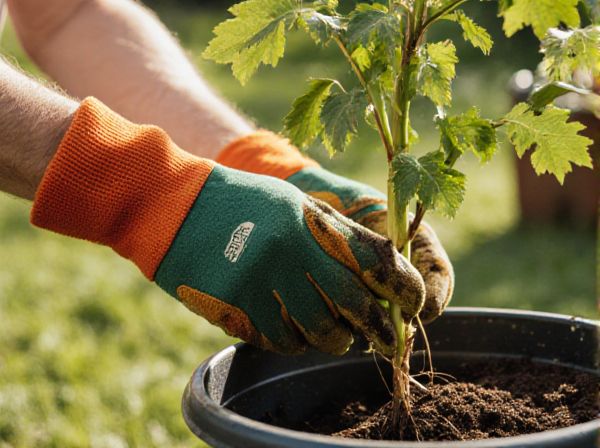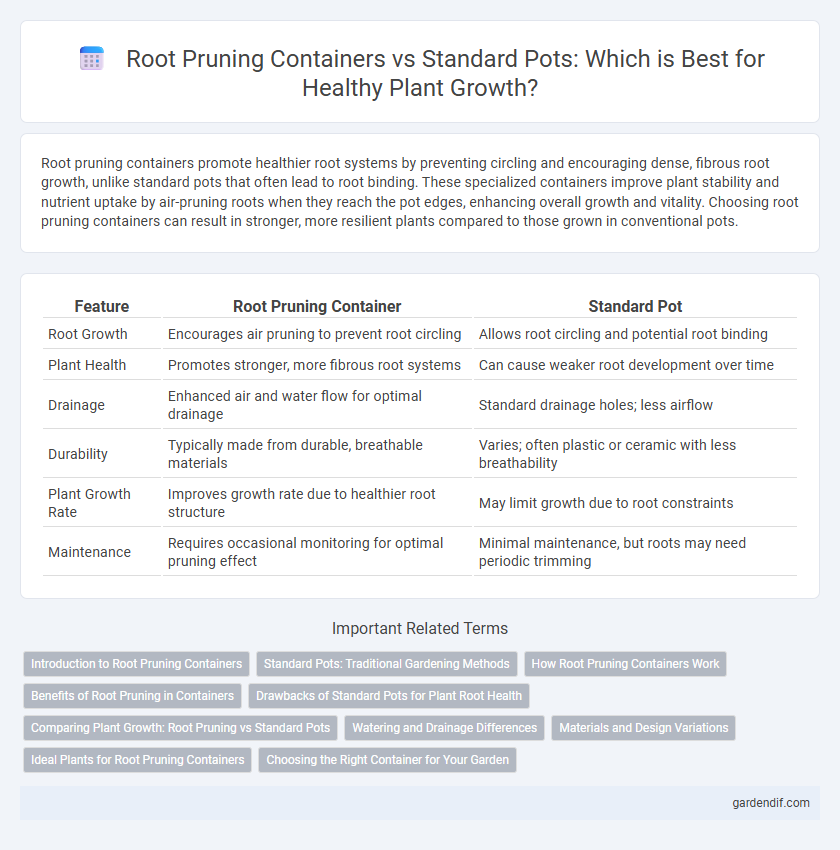
Root pruning container vs standard pot Illustration
Root pruning containers promote healthier root systems by preventing circling and encouraging dense, fibrous root growth, unlike standard pots that often lead to root binding. These specialized containers improve plant stability and nutrient uptake by air-pruning roots when they reach the pot edges, enhancing overall growth and vitality. Choosing root pruning containers can result in stronger, more resilient plants compared to those grown in conventional pots.
Table of Comparison
| Feature | Root Pruning Container | Standard Pot |
|---|---|---|
| Root Growth | Encourages air pruning to prevent root circling | Allows root circling and potential root binding |
| Plant Health | Promotes stronger, more fibrous root systems | Can cause weaker root development over time |
| Drainage | Enhanced air and water flow for optimal drainage | Standard drainage holes; less airflow |
| Durability | Typically made from durable, breathable materials | Varies; often plastic or ceramic with less breathability |
| Plant Growth Rate | Improves growth rate due to healthier root structure | May limit growth due to root constraints |
| Maintenance | Requires occasional monitoring for optimal pruning effect | Minimal maintenance, but roots may need periodic trimming |
Introduction to Root Pruning Containers
Root pruning containers are designed to promote healthier root systems by preventing root circling common in standard pots, encouraging air pruning that stimulates dense, fibrous root growth. These containers typically feature permeable walls or slits that expose roots to oxygen, enhancing nutrient absorption and overall plant vigor. Unlike traditional pots, root pruning containers reduce transplant shock and improve long-term plant stability in both nursery and home gardening settings.
Standard Pots: Traditional Gardening Methods
Standard pots are widely used in traditional gardening for their simplicity and availability, offering unrestricted root growth that can lead to root circling and potential plant stress. Unlike root pruning containers designed to air-prune roots and promote a dense fibrous root system, standard pots do not prevent root binding, which may reduce nutrient uptake efficiency over time. Gardeners relying on standard pots should monitor root health regularly to avoid common issues like root circling and ensure optimal plant development.
How Root Pruning Containers Work
Root pruning containers work by featuring a design that naturally directs roots toward air-exposed surfaces, which causes them to dry and prune themselves instead of circling. This air pruning stimulates the growth of a dense network of fine, fibrous roots, enhancing nutrient absorption and overall plant health. Unlike standard pots, which often lead to root circling and restricted growth, root pruning containers promote a more efficient and healthier root system.
Benefits of Root Pruning in Containers
Root pruning containers enhance plant health by promoting a dense, fibrous root system that prevents circling and root-bound issues common in standard pots. This improved root architecture increases nutrient and water uptake efficiency, leading to faster growth and stronger plants. The design also facilitates better aeration and drainage, reducing the risk of root rot and improving overall root zone conditions.
Drawbacks of Standard Pots for Plant Root Health
Standard pots restrict root growth due to limited aeration and drainage, often leading to root circling and poor nutrient absorption. These conditions create an anaerobic environment that promotes root rot and stunts plant development. Root pruning containers mitigate these drawbacks by enhancing air pruning, encouraging healthier and more robust root systems.
Comparing Plant Growth: Root Pruning vs Standard Pots
Root pruning containers promote healthier root systems by preventing circling roots and encouraging dense, fibrous root growth, which improves nutrient and water uptake. Standard pots often lead to root-bound conditions, restricting plant growth and reducing overall vigor. Studies show that plants grown in root pruning containers exhibit faster growth rates and enhanced biomass compared to those in conventional pots.
Watering and Drainage Differences
Root pruning containers feature specialized designs that enhance water distribution by encouraging root growth towards air-pruning surfaces, reducing waterlogging and promoting efficient drainage. Standard pots often accumulate excess water at the bottom due to limited airflow and fewer drainage holes, increasing the risk of root rot. The superior aeration in root pruning containers leads to healthier roots with improved moisture regulation and drainage compared to traditional pots.
Materials and Design Variations
Root pruning containers typically feature rigid plastic or fabric materials designed with air-permeable walls or internal ribs that encourage natural root pruning, preventing circling and promoting healthier root development. Standard pots are commonly made from plastic, ceramic, or terracotta with solid, non-permeable walls that can lead to root circling and less efficient root systems. Design variations in root pruning containers include air root pruning technologies and mesh sides, while standard pots prioritize durability and aesthetic finishes without specialized root control features.
Ideal Plants for Root Pruning Containers
Root pruning containers are ideal for plants with sensitive root systems such as bonsai, orchids, and certain herbs like mint, as they promote healthier root architecture and prevent root circling. Compared to standard pots, these containers enhance aeration and drainage, which is beneficial for promoting strong, fibrous roots in vegetables like tomatoes and peppers. Root pruning containers also support vigorous growth in woody plants and shrubs by encouraging root branching and reducing transplant shock.
Choosing the Right Container for Your Garden
Root pruning containers enhance plant growth by preventing root circling and promoting a healthier, fibrous root system, unlike standard pots that allow roots to spiral and potentially become root-bound. These specialized containers, often made of air-pruning fabric or rigid plastic with air holes, improve aeration and drainage, leading to stronger, more vigorous plants. Selecting a root pruning container ensures optimal root development and better water and nutrient uptake, making it ideal for long-term gardening success compared to traditional pots.
Root pruning container vs standard pot Infographic

 gardendif.com
gardendif.com